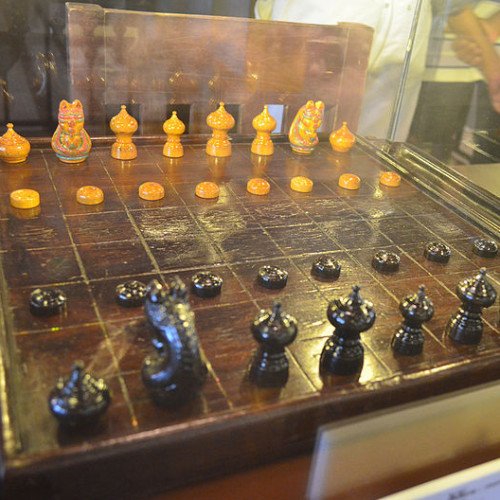CAMELOT VS MAKRUK

CAMELOT
Camelot is a strategy board game for two players. It was invented by George S. Parker late in the 19th century, and was one of the first games published by Parker Brothers, originally under the name Chivalry. The game was reissued as "Camelot" in 1930, with reduced size and number of pieces. It flourished through numerous editions and variants, achieving its greatest popularity in the 1930s, and remained in print through the late 1960s. Parker Brothers briefly republished the game in the 1980s under the name Inside Moves. Since then it has been out of print, but retains a core of fans anticipating another revival. Camelot is easy to learn and without extensive theory or praxis, making it perhaps more accessible for novices to play/enjoy compared to chess. Gameplay is exceptionally tactical almost from the first move, so games are quick to play to a finish. A World Camelot Federation exists, with free membership, led by Michael W. Nolan. Camelot was featured in Abstract Games magazine in 2001 and 2002. In 1882, George S. Parker began working on an abstract board game called Chivalry. His goal was to create a game not so difficult as chess, but considerably more varied than checkers. Parker created a game that was a complex, tactical, but an easily learned and quickly played mixture of Halma and checkers. When finally published by Geo. S. Parker & Co. in 1887, Chivalry won the raves of chess and checkers experts, but the game Parker called "the best game in 2000 years" did not catch on quickly with the general public. However, Parker never lost his enthusiasm for the game, and in 1930 he made a few changes, and Parker Brothers republished it under the name "Camelot". A few more rules changes followed in 1931. Camelot enjoyed its greatest popularity in the 1930s. Camelot players included José Raúl Capablanca, World Chess Champion from 1921 to 1927, and Frank Marshall, U.S. Chess Champion from 1907 to 1936. Sidney Lenz and Milton Work, two world-famous bridge players, also played the game. There were over 50 different editions of Camelot sets issued, including a gold-stamped leather edition and a mahogany cabinet edition. There were tournament editions, regular editions, and low-cost editions. Camelot was eventually discontinued in 1968, then reissued as "Inside Moves" in 1985, and finally discontinued again in 1986.
Statistics for this Xoptio

MAKRUK
Makruk or Thai chess, is a board game that is descended from the 6th-century Indian game of chaturanga or a close relative thereof, and is therefore related to chess. It is classified as a chess variant. The word "ruk" (Thai: รุก) in Thai is thought to derive from "rukh" which means "chariot" in the Persian language (and is also the common origin of the name for a rook in western chess). The Persian traders came to the Ayutthaya kingdom around the 14th century to spread their culture and to trade with the Thai kingdom. It is therefore possible that the Siamese Makruk, in its present form, was directly derived from the Persian game of Shatranj via the cultural exchange between the two people in this period. This is because the movement of Makruk Thai's queen, or the "seed" (Thai: เม็ด), is essentially the same as the ferz in Shatranj. The disadvantaged player announces the counting of his fleeing moves, starting from the number of pieces left on the board, including both kings. The winning player has to checkmate his opponent's king before the maximum number is announced, otherwise the game is declared a draw. During this process, the count may restart if the counting player would like to stop and start counting again. For example, if White has two rooks and a knight against a lone black king, he has three moves to checkmate his opponent (the given value of 8 minus the total number of pieces, 5). If Black captures a white rook, the count does not automatically restart, unless Black is willing to do so, at his own disadvantage. However, many players do not understand this and restart the counting while fleeing with the king.